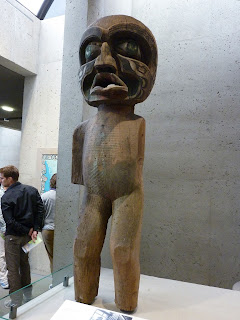Last week, one of my colleagues asserted that it didn't matter how a message was communicated – that the medium and the message were independent. I raised a quizzical eyebrow. A few days previously, I'd been in Vancouver, and had visited the Museum of Anthropology. It's a delightful place: some amazing art and artefacts from many different cultures. Most of them relate to ceremony and celebration, rather than everyday life, but they give a flavour of people's cultures, beliefs and practices. And most of them are beautiful.
One object that caught my attention was a yakantakw, or "speaking through post". According to the accompanying description: "A carved figure such as this one, with its prominent, open mouth, was used during winter ceremonies. A person who held the privilege of speaking on behalf of the hosts would conceal himself behind the figure, projecting his voice forward. It was as though the ancestor himself was calling to the assembled guests." This particular speaking through post dates from 1860, predating the Wizard of Oz by about 40 years.
In HCI, we talk about "Wizard of Oz experiments" in which participants are intended to believe that they are interacting with a computer system when in fact they are interacting with a human being who is hiding behind that system. It matters that people think that they are interacting with a computer rather than another human being. The analogy with the Wizard of Oz is quite obvious. But is looks like the native people in that region beat L. Frank Baum to the idea, and we should really be calling them "Yakantakw experiments". Just as soon as soon as we Western people learn to pronounce that word.
One object that caught my attention was a yakantakw, or "speaking through post". According to the accompanying description: "A carved figure such as this one, with its prominent, open mouth, was used during winter ceremonies. A person who held the privilege of speaking on behalf of the hosts would conceal himself behind the figure, projecting his voice forward. It was as though the ancestor himself was calling to the assembled guests." This particular speaking through post dates from 1860, predating the Wizard of Oz by about 40 years.
In HCI, we talk about "Wizard of Oz experiments" in which participants are intended to believe that they are interacting with a computer system when in fact they are interacting with a human being who is hiding behind that system. It matters that people think that they are interacting with a computer rather than another human being. The analogy with the Wizard of Oz is quite obvious. But is looks like the native people in that region beat L. Frank Baum to the idea, and we should really be calling them "Yakantakw experiments". Just as soon as soon as we Western people learn to pronounce that word.

No comments:
Post a Comment